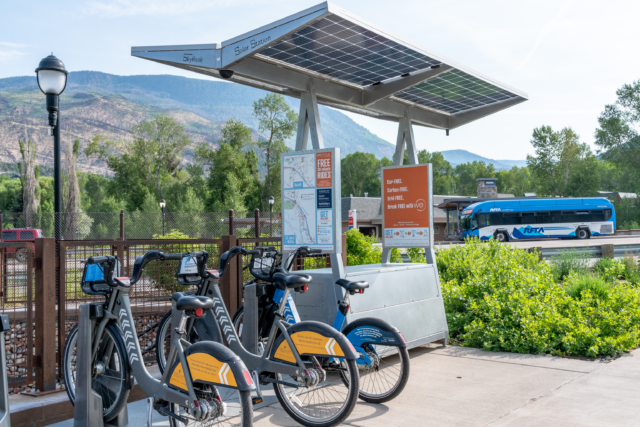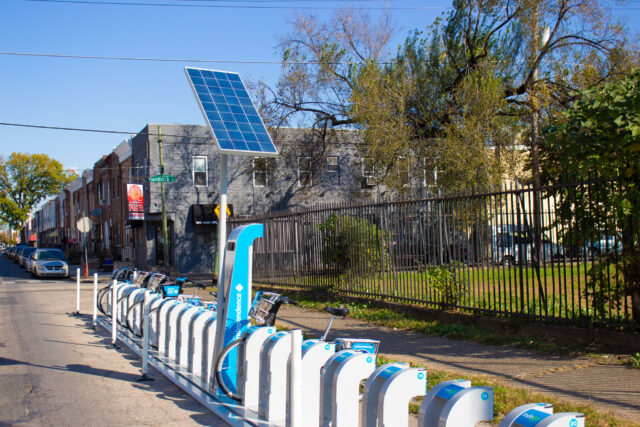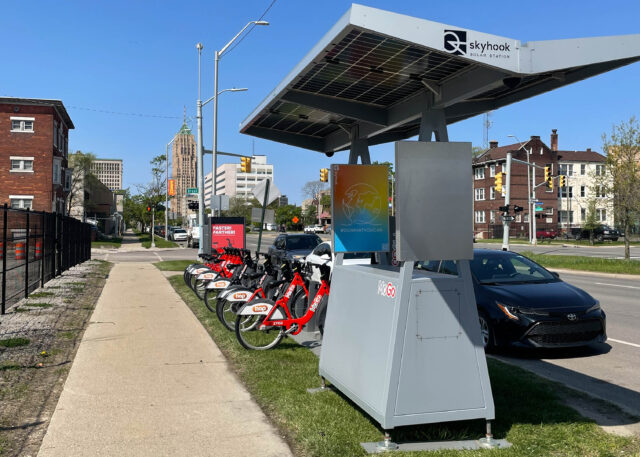Lessons on Solar-Powered Charging in Bike Share
by Odochi Akwani, Writer and Content Manager
February 18, 2025
Five different systems across North America share what solar charging means for their operations, including challenges and strategies.
As shared micromobility systems increasingly integrate electric bicycles into their fleets, the question of how to efficiently charge them remains a key consideration. Many systems are turning to solar-powered charging stations to reduce operational costs and emissions. We spoke with five shared micromobility programs to share learnings from their experiences with solar charging.
WHY GO SOLAR?
For Chicago’s Divvy system, solar-powered charging stations offered an opportunity to reduce rebalancing trips made by gas-powered vehicles.
“Divvy had an interest in charging stations because it cuts down on the need for rebalancing, on the number of trips that gas-powered vehicles have to take out to the various stations and swap out batteries, and often those swap outs happen during the most congested times for traffic in the city,” says Kyle Peppin, coordinating planner at the Chicago Department of Transportation. “So, it’s a way to reduce emissions. It’s a way to reduce congestion on some of our least accessible and most heavily used stations throughout the city.”
For WE-Cycle, solar power provided a way to bypass regulatory hurdles.
“The great thing about going with these solar units is there might be a lot of red tape at a particular site that you’re trying to get e-bike charging at,” says Jack Dimmit, system director for WE-Cycle. “For operations purposes, it makes the most sense for your busiest stations to charge the bikes. This can help get you around that.”

WE-Cycle’s solar-charging station
THE BENEFITS OF SOLAR
For many systems, solar has proven effective, especially during warmer months when daylight hours are long. Additionally, the ability to add solar-powered stations in locations where grid access is difficult is another advantage.
“During the summer, spring, and fall, when we’ve got 12-plus hours of daylight, they’re very effective in keeping stations charged,” says Nate Bowman Johnston, general manager of Bicycle Transit Systems, which operates Indego Bike Share in Philadelphia. “It’s extremely sustainable, renewable, and cost-effective.”
BIXI Montreal, which installed a single solar-powered charging station, has already seen substantial savings in operational efforts.
“Since the installation, we avoided around 800 battery swaps with that charging station,” says Tristan Bougie, advisor for planning and business intelligence at BIXI. “Because the station is so popular, the bikes don’t have time to charge fully. They stay for about 15 minutes before they’re taken out again. Even with just two to three partial charges per day, we’re avoiding significant battery swap operations.”
Additionally, using solar stations can free up resources for other critical operational needs.
“We can use that capacity for other things,” says Johnston. “Keeping stations up and running is very important to people’s experience, but if there are easy and efficient ways to do that, it frees up capacity to focus on things like bike availability, which is huge.”

Indego’s solar-powered station (powering the station itself)
CHALLENGES AND CONSIDERATIONS
Despite the advantages, solar-powered charging does come with limitations.
“You have a finite amount of power,” says Dimmit. “There’s a battery bank in the solar unit. In theory, you can charge overnight, but if you consume all the available power overnight when there isn’t active solar gain, you can run into a lapse in charging. The station will still operate as normal, but it just won’t charge the bikes.”
Cost remains another barrier.
“The biggest reservation for us is because it was our first e-bike charging station and the cost associated with it,” says Jacob Graham, director of programs and operations at MoGo Bike Share in Detroit. “It’s a relatively expensive piece of equipment. The electric bike charging station itself is more expensive than the regular station, so there are significant upfront costs that just make you think twice.”
For BIXI, urban integration is also a challenge.
“The costs of the Skyhook Solar [its solar station manufacturer] are quite high,” says Bougie. “And after a few years, the performance of the solar panel or battery pack might decrease. Also, it’s big and not very aesthetically pleasing, which makes integrating this huge solar panel into urban areas difficult.”
According to Daniel Delano, president and CEO of Skyhook Solar, the current fleet cost of a D4 Solar Station unit is $34,500. The base footprint of the unit is about 20 square feet. The solar canopy overhead is larger, at about 115.5 square feet, and consists of four or six industrial-size solar modules.
Beyond cost and aesthetics, reliability is also a concern for some cities. According to Peppin, Divvy found that their solar panel stations did not always reliably charge devices. When they encountered this issue, they opted for trenching as a more dependable alternative.
“That is part of why for the 100 or so stations that we are electrifying right now, we went with trenched underground charging,” says Peppin. “A large part of that as well is that the fixed costs associated with trenching, we were able to significantly reduce through a tariff with our electricity provider here in Chicago.”
The Chicago Department of Transportation has a tariff with ComEd, Chicago’s electricity provider, that stipulates ComEd covers the cost for the first 150 feet. CDOT is paying for the costs of installing the meter and potentially the podium. ComEd is paying to connect the station to the system.
Recognizing that solar charging may not be reliable in all conditions, Skyhook Solar offers a hybrid approach that integrates grid power as a supplement.
“Skyhook can work with a grid supplement where it makes sense, because in some locations — maybe very northern latitudes like Montreal, Toronto, or Chicago — you might want to supplement it with the grid,” says Delano.
The system draws from the grid only when necessary, ensuring consistent power while maintaining solar as the primary energy source.

MoGo’s solar-charging station
STRATEGIC IMPLEMENTATION
Shared micromobility systems have developed different strategies to mitigate the challenges associated with implementing solar charging.
“The strategy for this first one [station] was proximity to our warehouse because a lot of trips that our ops team is making are starting and ending at the warehouse anyway,” says Graham at MoGo. “So, this was a very convenient location to start off this kind of network.”
WE-Cycle took a phased approach, gradually expanding charging capacity to avoid early roadblocks.
“We’ve been steadily adding more and more charging capacity over the years,” says Dimmit. “If we had stuck with just the two stations we had in our first season, we would have definitely run into roadblocks. But because we’ve continually expanded, we’ve alleviated those concerns.”
Chicago’s Divvy system opted for a mixed approach, incorporating both solar and trenched underground charging stations.
“We install conduit from the ComEd sub line to the station itself,” says Peppin. “Then the meter, which is either in its own utility box or there are plans to put it within the station itself, captures how much electricity is being used, and the bikes are charged that way.”
THE FUTURE OF SOLAR CHARGING
While solar charging is not a one-size-fits-all solution, especially from system to system, shared micromobility systems still see it playing an essential role in long-term sustainability planning.
“Our target is for 20% of our stations to provide e-bike charging,” says Graham.
BIXI aims to use solar charging strategically rather than universally.
“We will keep this solution for certain sites where the connection to the grid is too expensive or complicated,” says Bougie. “We are adding between 20 and 30 electric stations every year, and the objective is to have at least 40% of our stations recharging bikes.”
Some systems are also considering innovative approaches to optimize energy use.
“We are starting to work with locking bikes at charging stations [at night] until they reach 60% charge before releasing them,” says Bougie. “That way, we ensure bikes are ready for the next day without relying on excessive battery swaps.”
In the future, advancements in battery storage and more efficient solar panels may further improve reliability. Some systems are even considering hybrid solutions that combine solar and grid power to ensure consistent availability year-round.
As shared micromobility systems continue optimizing their fleets, solar-powered charging stations remain a promising option for reducing emissions, cutting costs, and improving operational efficiency. While challenges exist, strategic implementation and continued innovation will help shared micromobility systems effectively leverage the many benefits of solar power.
_________________________________________________________________________________________
The Better Bike Share Partnership is funded by The JPB Foundation as a collaboration between the City of Philadelphia, the National Association of City Transportation Officials (NACTO), and the PeopleForBikes Foundation to build equitable and replicable bike share systems. Follow us on LinkedIn, Facebook, Twitter, and Instagram, or sign up for our weekly newsletter. Have a question or a story idea? Email odochi@peopleforbikes.org
